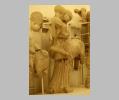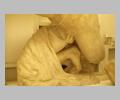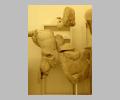
West Pediment, Figs. H & I (Group of bride? and centaur), view from le...

West Pediment, Fig. T (Kneeling Lapith), detail of lower torso and legs

West Pediment, Figs. H & I (Group of bride? and centaur), centaur mau...

West pediment, general view, Figs. C,D,E,F

West Pediment, Fig. A (Old woman) in foreground; Fig. B in center back

West Pediment, Figs. F,G (Lapith boy and centaur), view facing pediment
| Collection: | Olympia Archaeological Museum |
| Title: | Olympia, West Pediment Overview |
| Context: | From Olympia |
| Findspot: | Excavated at Olympia |
| Summary: | Battle of Lapiths and Centaurs |
| Material: | Marble |
| Sculpture Type: | Architectural |
| Category: | Statuary group |
| Placement: | West Pediment |
| Style: | Early Classical |
| Technique: | In-the-round |
| Original or Copy: | Original |
| Date: | ca. 470 BC - ca. 457 BC |
| Dimensions: | W of pediment 26.0 m; H of pediment at center 3.30 m |
| Scale: | Over life-size |
| Region: | Elis |
| Period: | Early Classical |
Subject Description:
The subject of the West Pediment, the fight between the Lapiths and the centaurs at the wedding of Peirithoos and Deidameia, is clearly identifiable from the physical remains. It is confirmed by Pausanias (
On either side of the central figure is a threesome of centaur, Lapith woman and hero, whose positions are a matter of controversy. The heroes must represent Theseus and Peirithoos, rather than Kaineos (again, Pausanias seems confused). Theseus is generally identified as Figure M, since he carries the axe mentioned by Pausanias. A nearly identical image appears on a krater in New York by the Painter of the Woolly Satyrs, including the garment fallen around the legs, while a similar representation exists on a
The figures which fill out the remainder of the pediment include other groups of centaurs attacking women and children as well as Lapith men struggling to free them. In the corners are prone women, apparently watching the fray. Figure A in the left-hand corner is usually thought to be a slightly later replacement of a figure probably damaged in an earthquake. Several centuries later Figures B and U were apparently added to fill the space between the corner and subsequent figures.
Unlike the Race between Oenomaos and Pelops on the East Pediment which had many connections with Olympia and the recent history of the sanctuary in particular, the disruption of the wedding of Peirithoos was set in Thessaly and had no specific connection with Olympia. However, centauromachies were extremely popular in Greek art and represented the struggle of the civilized world against barbarians. In the years following the invasion of the Persians and their repulsion by the Greeks, the period in which the Temple of Zeus was built, the subject was a reference to that crisis and ultimate victory of the Greeks and to the values for which they had stood.
Date Description:
See East Pediment.
Condition: Fragmentary
Condition Description:
Fragments of nineteen figures, plus two (B and U) which apparently were a late addition to the original design; figures broken into many fragments; heavily weathered.
Associated Building: Olympia, Temple of Zeus
Collection History:
Excavated by the Germans from 1875.
Sources Used: